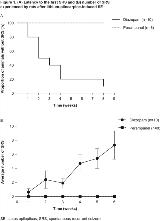Early Intervention With Perampanel Prevents Chronic Epilepsy and Behavioral Abnormalities in the Lithium-Pilocarpine Rat Model of Status Epilepticus (SE)
Abstract number :
2.231
Submission category :
7. Antiepileptic Drugs / 7A. Animal Studies
Year :
2018
Submission ID :
500767
Source :
www.aesnet.org
Presentation date :
12/2/2018 4:04:48 PM
Published date :
Nov 5, 2018, 18:00 PM
Authors :
Ting Wu, Eisai Co., Ltd.; Yoshihide Osada, Eisai Co., Ltd.; Yoshiaki Furuya, Eisai Co., Ltd.; Yoshimasa Ito, Eisai Co., Ltd.; Kazuyuki Fukushima, Eisai Co., Ltd.; and Katsutoshi Ido, Eisai Co., Ltd.
Rationale: Lithium-pilocarpine-induced SE triggers a series of biochemical changes, such as relevant plasticity changes in AMPA receptors, which are associated with neuronal loss, spontaneous seizure occurrence, cognitive deficits, and behavioral abnormalities. Cell surface trafficking of AMPA receptors, which plays a crucial role in the development and maintenance of seizures, reportedly changes in the acute phase of SE. Perampanel, a selective AMPA receptor antagonist, has been reported to terminate established, diazepam-resistant SE and prevent neuronal loss in the lithium-pilocarpine model, and was found to be more potent than conventional AEDs (Hanada et al. Pharmacol Res Perspect 2014;2:e00063; Wu et al. Epilepsy Res 2017;137:152-158). We examined whether perampanel compared with diazepam could prevent changes in cell surface trafficking of AMPA receptors in the acute phase of SE and subsequently prevent chronic electrophysiological and behavioral abnormalities. Methods: Lithium chloride (3 mEq/kg) was intraperitoneally administered to 6-week-old male Sprague Dawley rats. This was followed 18–26 hours later by co-administration of pilocarpine (30 mg/kg) and scopolamine methyl bromide (5 mg/kg). Perampanel (6 mg/kg; n=8) or diazepam (10 mg/kg; n=10) was administered intravenously 30 minutes after seizure initiation. To evaluate SE-induced change of AMPA receptor cell surface trafficking, ratio of phosphorylated to total GluR1 (p-GluR1/GluR1) in the hippocampus was analyzed by western blotting 30 minutes (treatment-naïve and vehicle-treated control rats) and 1.5 hours after seizure initiation (treatment-naïve, vehicle-treated control, diazepam-treated, and perampanel-treated rats). Electroencephalography measurements examined latency to first spontaneous recurrent seizure (SRS) and interictal spike (IIS) for 8 weeks by utilizing the Dataquest ART system. Y maze spontaneous alternation test was performed at 7 weeks after SE initiation. Results: Perampanel, unlike diazepam, prevented SE-induced decrease of p-GluR1/GluR1 in the acute phase of SE. During the 8-week period, perampanel prevented SRS occurrence completely, whereas SRS was observed in 90% of diazepam-treated rats. Average number of SRS increased time dependently in the diazepam-treated group (Figure 1). All of the diazepam-treated and half of the perampanel-treated rats developed IIS, but the average number of IIS was significantly lower in the perampanel-treated group than the diazepam-treated group (p<0.05). In the Y maze test, diazepam-treated rats had increased total arm entry and decreased alternation rate, but perampanel-treated rats did not show these behavioral abnormalities (Figure 2). Conclusions: In the present study, we demonstrated that intervention with perampanel in lithium-pilocarpine-induced SE prevented biochemical changes and chronic abnormalities associated with SE, such as SRS occurrence and cognitive deficits. These results suggest that inhibiting AMPA receptors in the acute phase of SE is important for favorable prognosis. Funding: Eisai Co., Ltd.

.tmb-.jpg?Culture=en&sfvrsn=653583ea_0)